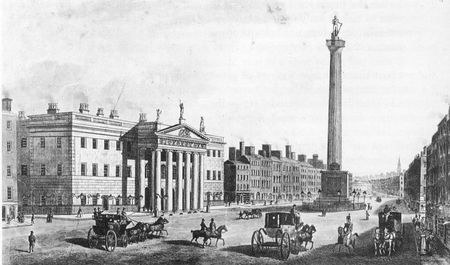Annotation:Nelson's Pillar: Difference between revisions
m (Text replacement - "garamond, serif" to "sans-serif") |
No edit summary |
||
| Line 1: | Line 1: | ||
== | __NOABC__ | ||
<div class="noprint"> | |||
<p><font face="Century Gothic" size="4"> Back to [[{{BASEPAGENAME}}]] </font></p> | |||
</div> | |||
---- | ---- | ||
<p><font face=" | {{#lst:{{PAGENAME}}|abc}} | ||
---- | |||
<div style="page-break-before:always"></div> | |||
<p><font face="Century Gothic" size="3"> | |||
<div style="text-align: justify; direction: ltr; margin-bottom: 90px; margin-left: 70px; margin-right: 120px;"> | |||
<br> | |||
'''NELSON'S PILLAR''' (Colún Nelson). AKA and see "[[Kane's Reel (2)]]," "[[Miss Smyth's Reel]]," "[[Naval Pillar (2) (The)]]." Irish, Reel. D Major. Standard tuning (fiddle). AABB. Fr. John Quinn finds a precursor version in "[[Naval Pillar (2) (The)]]," found in Dublin publisher Maurice Hime's '''Hime's Collection of Favourite Country Dances for the Present Year''' (1795, No. 11). A County Leitrim setting of the tune that was collected as "Kane's" in County Fermanagh or Tyrone. Fiddler Larry Smyth (Abbeylara, Co. Longford) entered it into his c. 1900 manuscript collection under the title "[[Miss Smyth's Reel]]." | '''NELSON'S PILLAR''' (Colún Nelson). AKA and see "[[Kane's Reel (2)]]," "[[Miss Smyth's Reel]]," "[[Naval Pillar (2) (The)]]." Irish, Reel. D Major. Standard tuning (fiddle). AABB. Fr. John Quinn finds a precursor version in "[[Naval Pillar (2) (The)]]," found in Dublin publisher Maurice Hime's '''Hime's Collection of Favourite Country Dances for the Present Year''' (1795, No. 11). A County Leitrim setting of the tune that was collected as "Kane's" in County Fermanagh or Tyrone. Fiddler Larry Smyth (Abbeylara, Co. Longford) entered it into his c. 1900 manuscript collection under the title "[[Miss Smyth's Reel]]." | ||
<br> | <br> | ||
<br> | <br> | ||
[[File:nelsonspillar.jpg| | [[File:nelsonspillar.jpg|450px|thumb|left|The Post Office and Nelson's Pillar, Dublin]] | ||
Nelson's Pillar [http://en.wikipedia.org/wiki/Nelson%27s_Pillar] was a distinctive monument located in the midst of O'Connell Street, Dublin, erected in 1808-09 to commemorate Admiral Nelson's victory and death at the Battle of Trafalgar (1805). The Tuscan pedestal and column rose 121 feet above the street and was capped by a statue of Nelson. Despite its being a tribute to an English hero, Nelson's Pillar survived (albeit not without protest) after Irish independence until 1966, when the upper half was blown apart by an IRA bomb, necessitating dismantling the remainder (which caused more damage to the surrounding area than the original blast). | Nelson's Pillar [http://en.wikipedia.org/wiki/Nelson%27s_Pillar] was a distinctive monument located in the midst of O'Connell Street, Dublin, erected in 1808-09 to commemorate Admiral Nelson's victory and death at the Battle of Trafalgar (1805). The Tuscan pedestal and column rose 121 feet above the street and was capped by a statue of Nelson. Despite its being a tribute to an English hero, Nelson's Pillar survived (albeit not without protest) after Irish independence until 1966, when the upper half was blown apart by an IRA bomb, necessitating dismantling the remainder (which caused more damage to the surrounding area than the original blast). | ||
<br> | <br> | ||
<br> | <br> | ||
</div> | |||
</font></p> | </font></p> | ||
<p><font face=" | <div class="noprint"> | ||
''Source for notated version'': a c. 1883 collection by fiddler and uilleann piper [[Biography:Stephen Grier]] (County Leitrim) [Breathnach]. | <p><font face="Century Gothic" size="3"> '''Additional notes''' </font></p> | ||
<p><font face="Century Gothic" size="3"> | |||
<font color=red>''Source for notated version''</font>: - a c. 1883 collection by fiddler and uilleann piper [[Biography:Stephen Grier]] (County Leitrim) [Breathnach]. | |||
<br> | <br> | ||
<br> | <br> | ||
</font></p> | </font></p> | ||
<p><font face=" | <p><font face="Century Gothic" size="3"> | ||
''Printed sources'': Breathnach ('''CRÉ IV'''), 1996; No. 133(ii), p. 66. | <font color=red>''Printed sources''</font> : - Breathnach ('''CRÉ IV'''), 1996; No. 133(ii), p. 66. | ||
<br> | <br> | ||
<br> | <br> | ||
</font></p> | </font></p> | ||
<p><font face=" | <p><font face="Century Gothic" size="3"> | ||
''Recorded sources'': <font color=teal></font> | <font color=red>''Recorded sources'': </font> <font color=teal> - </font> | ||
</font></p> | </font></p> | ||
<br> | <br> | ||
---- | ---- | ||
== | <p><font face="Century Gothic" size="4"> Back to [[{{BASEPAGENAME}}]] </font></p> | ||
</div> | |||
__NOEDITSECTION__ | |||
__NOTITLE__ | |||
Revision as of 05:20, 10 February 2020
X:1 T:Nelson’s Pillar M:C L:1/8 R:Reel B:Stephen Grier music manuscript collection (Book 2, c. 1883, No. 13, p. 4) B: http://grier.itma.ie/book-two#?c=0&m=0&s=0&cv=3&z=-284.2933%2C776.5536%2C4235.3267%2C1481.5886 N:Stephen Grier (c. 1824-1894) was a piper and fiddler from N:Newpark, Bohey, Gortletteragh, south Co. Leitrim. Z:AK/Fiddler’s Companion K:D DFAd edfd|Bc/d/ AF GFEF|DFAd edfd|BdAG FD D2|| fdd/d/d bdad|gefd cdeg|fdd/d/d BdAd|FdEc dD D2||
NELSON'S PILLAR (Colún Nelson). AKA and see "Kane's Reel (2)," "Miss Smyth's Reel," "Naval Pillar (2) (The)." Irish, Reel. D Major. Standard tuning (fiddle). AABB. Fr. John Quinn finds a precursor version in "Naval Pillar (2) (The)," found in Dublin publisher Maurice Hime's Hime's Collection of Favourite Country Dances for the Present Year (1795, No. 11). A County Leitrim setting of the tune that was collected as "Kane's" in County Fermanagh or Tyrone. Fiddler Larry Smyth (Abbeylara, Co. Longford) entered it into his c. 1900 manuscript collection under the title "Miss Smyth's Reel."

Nelson's Pillar [1] was a distinctive monument located in the midst of O'Connell Street, Dublin, erected in 1808-09 to commemorate Admiral Nelson's victory and death at the Battle of Trafalgar (1805). The Tuscan pedestal and column rose 121 feet above the street and was capped by a statue of Nelson. Despite its being a tribute to an English hero, Nelson's Pillar survived (albeit not without protest) after Irish independence until 1966, when the upper half was blown apart by an IRA bomb, necessitating dismantling the remainder (which caused more damage to the surrounding area than the original blast).
